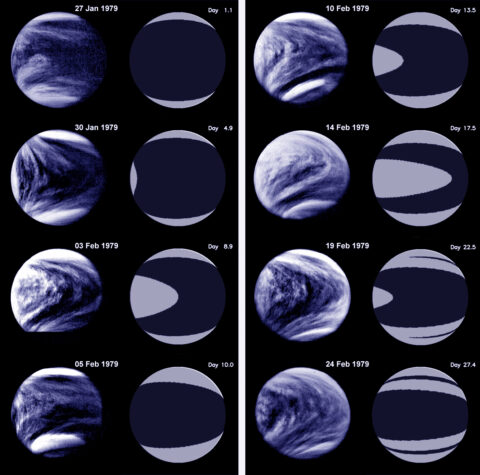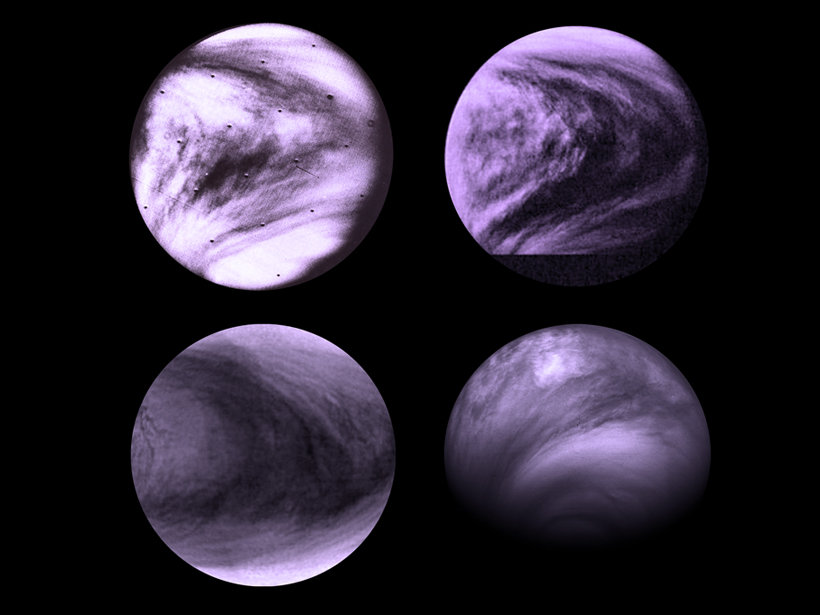Source: Geophysical Research Letters
Venus’s windy atmosphere has perplexed scientists for decades. Unlike Mars’s and Earth’s atmospheres, which rotate at roughly the same speed as their surfaces, Venus’s atmosphere rotates a whopping 60 times faster than the planet itself, a phenomenon known as superrotation whose origins have yet to be satisfactorily resolved. Venus’s atmosphere completes a rotation around the planet in just four Earth days, whereas the planet itself completes one rotation around its axis in 243 Earth days. Because of the combination of Venus’s rotational speed and the velocity at which it orbits the Sun, the time between two sunsets on Venus is actually 117 Earth days. Meanwhile, it takes 224 Earth days for Venus to complete one orbit around the Sun.

One iconic side effect of Venus’s speedy atmospheric revolution is an anomalous, planetary-scale cloud structure—known as the Y feature for its resemblance to the letter Y—that spreads perpendicularly across the planet. Since its discovery in the 1960s, scientists have hypothesized that atmospheric waves are responsible for forming this structure. Yet they’ve struggled to accurately model its shape, wind patterns, and life cycle or identify the mysterious ultraviolet-absorbing substance that gives it its dark appearance.
Peralta et al. have presented an analytical model of a new type of atmospheric wave (a Kelvin-like wave) that can exist over planets with atmospheric superrotation like Venus and that seems to explain most of the Y feature’s peculiarities. They also showed that previous studies interpreting the Y feature as equatorial waves like those present on Earth were not suitable because Venus’s atmospheric regime is radically different. The current study suggests that this new type of wave may explain how the Y feature may push up and concentrate ultraviolet-absorbing material, giving the feature its dark appearance.
Additionally, the Y’s distinct shape may be due to the difference in wind speeds across the planet. Since winds at higher latitudes travel shorter distances to complete one circle around the globe than winds at the equator, the wave propagating within the winds gets distorted. Using the wind velocities measured during the Pioneer Venus mission, the authors have been able reproduce, also for the first time, the time evolution of the Y feature as displayed by observations.
The team hopes to eventually apply this model to other slowly rotating bodies like Titan, the largest moon of Saturn, as well as other planets outside the solar system suspected of having atmospheric superrotation. Future iterations of the model, the group says, should include Venus’s north–south meridional airflow patterns and an examination of other sources that may excite these waves. (Geophysical Research Letters, doi:10.1002/2014GL062280, 2015)
—Julia Calderone, Freelance Writer
Citation: Calderone, J. (2015), New atmospheric wave may shape Venus’s clouds, Eos, 96, doi:10.1029/2015EO037099. Published on 16 October 2015.
Text © 2015. The authors. CC BY-NC 3.0
Except where otherwise noted, images are subject to copyright. Any reuse without express permission from the copyright owner is prohibited.

